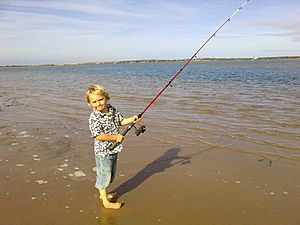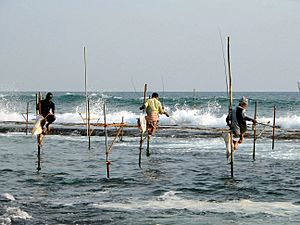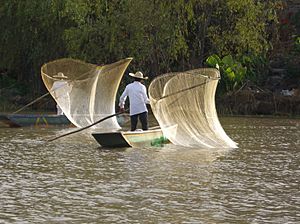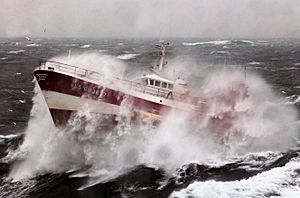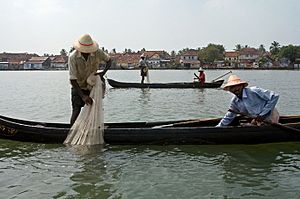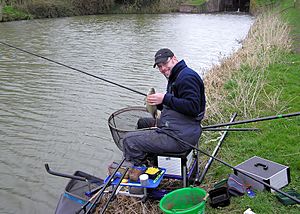Fishing facts for kids
Fishing is when people try to catch fish. You can fish in the sea, a lake, or a river. People fish from a boat or from the shore.
Fish are usually caught in the wild. Some ways to catch fish include using your hands, spears, nets, angling (with a rod and line), or traps.
The word "fishing" can also mean catching other water animals. This includes molluscs like clams, cephalopods like squid, crustaceans like crabs, and echinoderms like sea urchins. We usually do not use the term "fishing" for farmed fish. For water mammals like whales, we use the word whaling.
The FAO says there are about 38 million commercial fishermen and fish farmers worldwide. Fisheries and aquaculture give jobs to over 500 million people in developing countries. In 2005, people around the world ate about 14.4 kilograms of wild fish per person. They also ate 7.4 kilograms more from fish farms. Besides providing food, fishing is also a fun recreational sport.
Contents
Fishing as a Job
Fishing for money is a very dangerous job. People can get hurt or even die. Fishing provides a lot of food for many countries. But those who fish for a living often go far into the ocean. They work in tough conditions.
Commercial fishermen catch many kinds of sea animals. This includes fish like tuna, cod, and salmon. They also catch animals without backbones, such as shrimp, lobster, clams, and squid. Alaskan king crab fishing is a well-known example of this.
Modern ways to fish for money are very efficient. They use large nets and machines to catch many animals. Many countries now have rules about how much fish people can catch. This is because some types of fish have become scarce, meaning there are not many left.
Raising fish in aquaculture (freshwater) and mariculture (saltwater) helps. These methods add to the amount of fish caught in the wild.
Fishing for Fun (Sport Fishing)
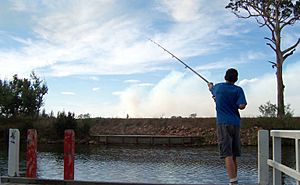
Sport fishing is usually done with a fishing rod and line. It uses hooks to catch fish. This method is called angling. There might be rules about how many lines and hooks a fisherman can use. There are also rules about how many fish they can catch.
Anglers in fresh water catch many types of fish. These include Black Bass, Pike, Muskellunge, Perch, Carp, Trout, Salmon, and Sunfish. In saltwater, people catch fish like Swordfish, Marlin, and Tuna.
Rules generally do not allow using nets for sport fishing. They also do not allow catching fish with hooks not in the mouth. However, some kinds of fish can be caught with nets for bait. A few types can also be caught for food. Non-sport fish, which are not considered as valuable, can sometimes be caught in other ways. These include snagging, using a bow and arrow, or even a gun. This is because they are sometimes seen as competing with more valuable fish.
Recreational fishing laws also cover other water animals. This includes frogs and turtles.
Sport fishing can also be a contest. Fishermen try to catch more fish than others. This sport grew from small local contests. Now, there are large contests in the U.S.A. and around the world. Skilled fishermen can compete and even win prize money from companies.
Catch and Release
Catch-and-release fishing is becoming more popular. It is often practiced by fly fishermen, as well as spin and bait casting fishermen. This method helps with conservation and protects rare fish like marlin.
However, some people do not agree with this practice. They think it is wrong to cause pain to fish just for fun, and not for food. Because of this, catch-and-release fishing is against the law in Norway.
Collecting Live Fish and Using Traps
Fish can also be collected in ways that do not hurt them. For example, a seine net can be used. This is done for observation and study, or for keeping fish in an Aquarium. There is a big industry that collects, transports, exports, and farms live fish. These are usually freshwater or marine tropical fish.
Fish can also be caught using traps. These traps are designed to catch fish without injuring them.
Overfishing: A Big Problem

In the past, fishing was so profitable that people started overfishing. This means catching too many fish. Overfishing is a serious problem that causes a lot of harm.
Overfishing does not always mean a fish type will become extinct. It simply means that so many fish of one type have been caught that there are not as many as before. As more boats go out to catch fish, the number of fish of a certain type can drop. Then, there are not enough of that kind of fish left to have new fish.
Many times, fishing boats catch fish they did not mean to catch. This is called bycatch. All kinds of fish can become bycatch. They are usually thrown back into the sea after they have died. Drift net fishing sometimes catches animals like seals, dolphins, whales, and sea turtles. This kind of fishing caused many complaints. In the 1980s, it was thought that 18 miles (30 km) of nets were lost every night. These lost nets would tangle up boats and animals.
Related pages
Images for kids
-
Stone Age fish hook made from bone
-
Painting of A Brixham trawler by William Adolphus Knell. The painting is now in the National Maritime Museum.
-
Izaak Walton's Compleat Angler, published in 1653 helped popularise fly fishing as a sport. Woodcut by Louis Rhead
-
Fishing became a popular recreational activity in the 19th century. Print from Currier and Ives.
-
A fisherman on the rapids in Nukari, Nurmijärvi, Finland
-
Modern Spanish tuna purse seiner in the Seychelles
See also
 In Spanish: Pesca para niños
In Spanish: Pesca para niños


